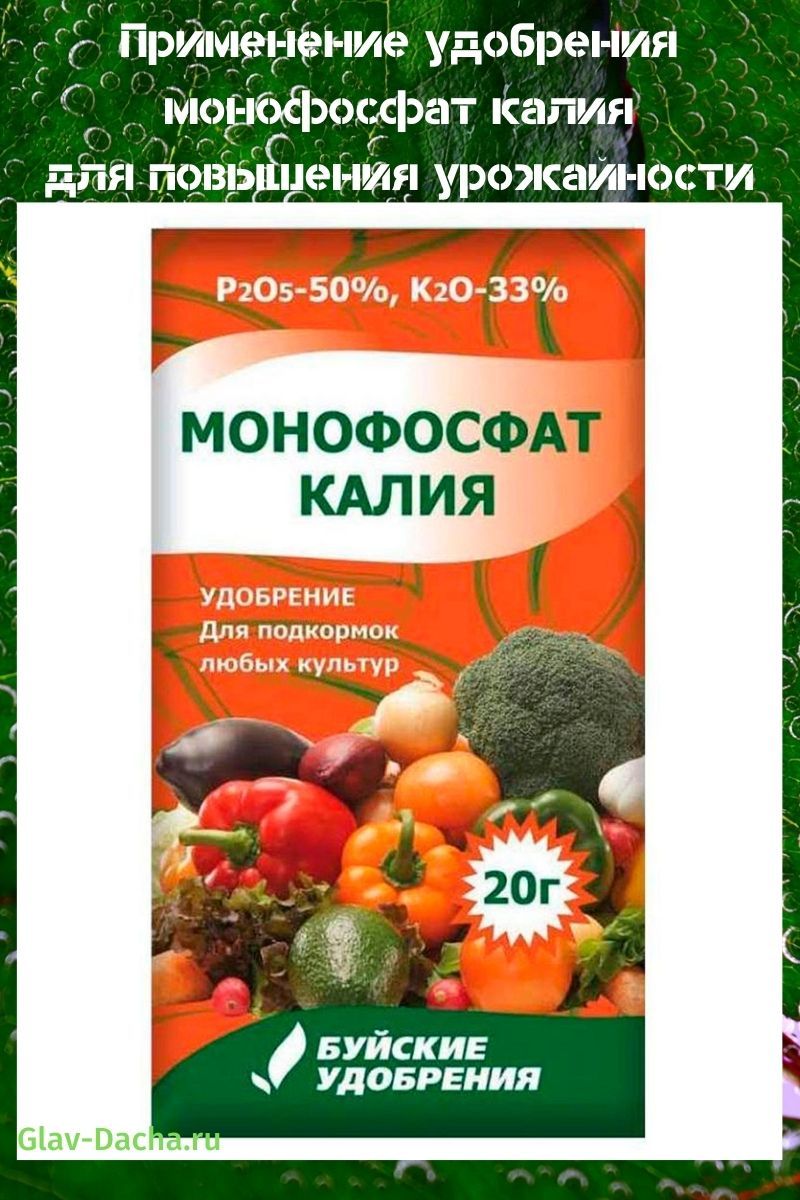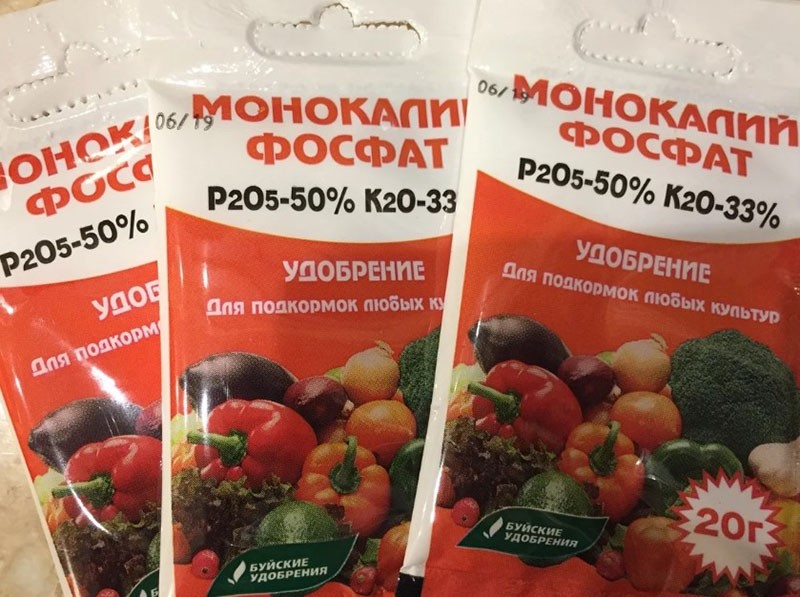Application of potassium monophosphate fertilizer to increase yields
 The cultivation of garden ornamental plants is impossible without potassium and phosphorus, which they need for active growth and high yield. The use of potassium monophosphate fertilizer, which has a balanced composition, allows plants to be saturated with useful trace elements required for better formation and ripening of fruits. Also, potassium monophosphate improves the fertile qualities of the soil and increases the resistance of crops to common diseases.
The cultivation of garden ornamental plants is impossible without potassium and phosphorus, which they need for active growth and high yield. The use of potassium monophosphate fertilizer, which has a balanced composition, allows plants to be saturated with useful trace elements required for better formation and ripening of fruits. Also, potassium monophosphate improves the fertile qualities of the soil and increases the resistance of crops to common diseases.
Potassium monophosphate - features and composition

Monopotassium phosphate is an easily soluble substance that instantly dissolves in water, allowing for quick results. The substance is available in the form of powder and granules.
The fertilizer composition of potassium monophosphate is represented by phosphorus 50-55% and potassium 33%:
- Potassium - normalizes the water-salt metabolism in plants, increases their immunity to various infections and diseases. Potassium stimulates the saturation of fruits with starch and sugars, improving their firmness and taste.
- Phosphorus - participates in the photosynthesis of plants, contributes to the rapid growth of vegetative mass, the formation of ovaries and the strengthening of the root system.
When applying the fertilizer, potassium monophosphate forms orthophosphoric acid, which is quickly absorbed by plant cells and does not negatively affect the structure of the soil.
Potassium monophosphate fertilizer application - benefits for plants
 When using potassium monophosphate fertilizer, it is possible to stimulate the growth and fruiting of vegetable plantings, berry bushes and fruit trees, to prolong the flowering of ornamental crops. This product is versatile - it can be used for both garden and indoor plants.
When using potassium monophosphate fertilizer, it is possible to stimulate the growth and fruiting of vegetable plantings, berry bushes and fruit trees, to prolong the flowering of ornamental crops. This product is versatile - it can be used for both garden and indoor plants.
The main advantages of potassium monophosphate:
- increases plant resistance to fungal and infectious diseases;
- increases crop productivity;
- strengthens the immunity of plants, helping them to easily endure frosts;
- saturates dry soil with moisture;
- does not affect the acidity of the soil;
- increases the number of shoots in young seedlings;
- it is combined with pesticides, therefore it can be used in complex processing.
Potassium monophosphate does not contain harmful salts of sodium, chlorine and other heavy metals, therefore, even an increased dosage of monopotassium phosphate does not burn the foliage and root system.
Rules for the use of potassium monophosphate
 Potassium monophosphate is a universal top dressing that can be used throughout the entire growing season of plant development.
Potassium monophosphate is a universal top dressing that can be used throughout the entire growing season of plant development.
When potassium monophosphate is used:
- spring together with nitrogen fertilizers, during planting seedlings in a permanent place in the beds;
- after prolonged rains, which wash out potassium and phosphorus from the garden soil;
- to increase crop yields during flowering and fruit formation.
The use of potassium monophosphate as a top dressing is recommended in case of signs of potassium and phosphorus deficiency. The deficiency of useful microelements is manifested by slow growth of plants, fadedness, yellowing and wilting of foliage with rapid withering away.
Before diluting potassium monophosphate, you need to carefully study the instructions, since the dosage of the drug differs depending on the type of plant being treated.
In most cases, a working solution with a concentration of 0.05 to 0.15% is used. For its preparation, from 5 to 15 g of powder or granules of potassium monophosphate is dissolved in a bucket of water.
For seedlings
 Potassium monophosphate is allowed to be used only after 3-4 true leaves appear. For seedlings, a solution is prepared from 10 g of the drug per 10 liters of water. Top dressing is carried out in two stages and only after preliminary moistening of the soil.
Potassium monophosphate is allowed to be used only after 3-4 true leaves appear. For seedlings, a solution is prepared from 10 g of the drug per 10 liters of water. Top dressing is carried out in two stages and only after preliminary moistening of the soil.
The first watering with potassium monophosphate is done immediately after the appearance of the first 2-4 leaves, the second - 12-16 days after transplanting into open ground. For the second feeding, the solution is used in the same concentration.
For tomatoes and cucumbers
 The use of monopotassium phosphate for tomatoes allows them to accelerate their growth, increase productivity, improve the taste and keeping quality of fruits.
The use of monopotassium phosphate for tomatoes allows them to accelerate their growth, increase productivity, improve the taste and keeping quality of fruits.
Basic rules for using potassium monophosphate for tomatoes:
- top dressing should be used no more than 1-2 times during the entire growing season;
- the break between fertilization should be at least 15-20 days;
- for feeding tomatoes, a solution of potassium monophosphate with a concentration of 0.15% is used - for its preparation, 15 g of feeding and 10 liters of water are required;
- in the case of a long period of rains, potassium is washed out of the soil, phosphorus and tomatoes may suffer from a lack of them - to fill the deficit, foliar spraying with a solution of 0.15% is carried out;
- under each bush, you need to pour at least 2 liters of the prepared solution.
Fertilization of cucumbers follows a similar scheme, using watering. It is advisable to carry out such feeding before watering.
For potatoes, root vegetables, garlic and onions
 Spraying with potassium monophosphate solution helps to increase the yield of potatoes, carrots, beets, garlic and onions. To fertilize these vegetable crops, a working solution with a concentration of 0.1-0.2% is used.
Spraying with potassium monophosphate solution helps to increase the yield of potatoes, carrots, beets, garlic and onions. To fertilize these vegetable crops, a working solution with a concentration of 0.1-0.2% is used.
Processing of root crops and bulbous plants should be carried out no more than twice during the growing season. The first is desirable to produce during the formation of tubers, the second - after 20-25 days.
For fruit trees and berry bushes
 Potassium monophosphate is used to feed apple, pear, plum and other fruit trees, as well as various berry bushes by watering or spraying. For this, a working solution with an increased concentration is used - up to 25-30 g of powder or granules per 10 liters of water.
Potassium monophosphate is used to feed apple, pear, plum and other fruit trees, as well as various berry bushes by watering or spraying. For this, a working solution with an increased concentration is used - up to 25-30 g of powder or granules per 10 liters of water.
For young shrubs and small fruit trees, a standard dosage of 15 grams of potassium monophosphate per bucket of water can be used. The processing of horticultural crops is carried out in several stages - after the end of the flowering period, 3-4 weeks after the first treatment. The final top dressing is carried out in September to increase the frost resistance and immunity of the tree or shrub.
For grapes
 The use of potassium monophosphate for grapes is carried out by sprinkling. For this purpose, powder or granules are used in an amount of 15 g per 10 liters of pure water. The average consumption rate of the prepared product is 4-5 liters per sq. m. Treatment with monopotassium phosphate is best done in the fall, during preparing the vine for winter.
The use of potassium monophosphate for grapes is carried out by sprinkling. For this purpose, powder or granules are used in an amount of 15 g per 10 liters of pure water. The average consumption rate of the prepared product is 4-5 liters per sq. m. Treatment with monopotassium phosphate is best done in the fall, during preparing the vine for winter.
Potassium monophosphate will help not only increase the yield of the vineyard, but also strengthen its resistance to fungal diseases. To do this, the vine should be sprayed with a solution with a concentration of 0.2%.
For flowers
 Applying potassium monophosphate to flowers helps to speed up flowering, make it more lush and long lasting. Top dressing must be applied during bud formation. In the absence of pronounced signs of a lack of potassium and phosphorus, a dosage of 0.1% is used. The consumption rate of the working solution is at least 4 liters per 1 sq. m.
Applying potassium monophosphate to flowers helps to speed up flowering, make it more lush and long lasting. Top dressing must be applied during bud formation. In the absence of pronounced signs of a lack of potassium and phosphorus, a dosage of 0.1% is used. The consumption rate of the working solution is at least 4 liters per 1 sq. m.
The use of potassium monophosphate fertilizer for roses is recommended for earlier flowering. If there are 3-4 strong and healthy leaves on the flowers, the concentration of the solution changes to 0.02%.
The same spraying is carried out for petunias, phloxes, tulips, and also ampelous plants.
Fertilizer analogs
 In the absence of monopotassium phosphate, it can be replaced with other mineral fertilizers that have a similar effect on vegetable, garden and ornamental crops.
In the absence of monopotassium phosphate, it can be replaced with other mineral fertilizers that have a similar effect on vegetable, garden and ornamental crops.
What can replace potassium monophosphate:
- Potassium nitrate - an excellent source of nitrogen and potassium, strengthens the immune system of plants and improves the palatability of fruits.
- Superphosphate - contains a combination of phosphorus and nitrogen. Improves the growth of the green part of crops and strengthens the root system.
- Wood ash is a natural fertilizer that contains potassium. Its concentration depends on the type of raw wood raw material.
Potassium monophosphate is a highly effective fertilizer for vegetable, horticultural and ornamental crops. This feeding has a complex effect. It stimulates plant growth, strengthens the immune system and the root system. Protects against many diseases and increases yields.